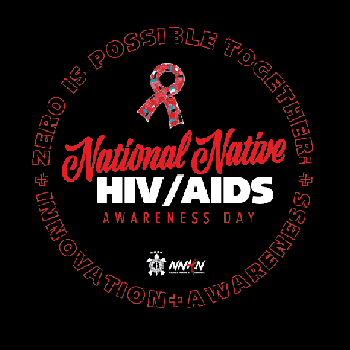National Native HIV/AIDS Awareness Day
National Native HIV/AIDS Awareness Day (NNHAAD) highlights efforts to address HIV and raise awareness of its impact in American Indian/Alaska Native (AI/AN) communities. First observed in 2007, NNHAAD encourages HIV education, testing, prevention, and treatment among AI/AN communities. The National Native HIV Network organizes NNHAAD, held annually on March 20, and coordinates related activities.
Issues such as HIV-related stigma, lack of awareness, and limited access to HIV services contribute to a disproportionate impact of HIV in AI/AN communities. According to the Centers for Disease Control and Prevention (CDC):
- There were 3,270 AI/AN individuals with HIV in the United States in 2021.
- There were an estimated 223 new HIV diagnoses among AI/AN individuals in 2021.
- For every 100 AI/AN people with HIV, an estimated 80 people are aware of their HIV status—the lowest rate of any racial or ethnic group.
The National Institutes of Health (NIH) HIV research program, coordinated by the NIH Office of AIDS Research (OAR), supports research to reduce HIV-related disparities based on race and ethnicity. This includes efforts to better understand and address HIV-related stigma and discrimination, which can discourage people from accessing HIV services. NIH HIV research also looks at the most effective ways to encourage AI/AN populations to access HIV testing, prevention, and treatment services. Efforts to address HIV among AI/AN populations must recognize diversity among Tribal communities and ensure interventions are culturally appropriate.

Additional Resources
NIH Office of AIDS Research
- FY 2021-2025 NIH Strategic Plan for HIV and HIV-Related Research provides a roadmap for NIH to guide HIV and HIV-related research and direct HIV research funding to the highest-priority areas to help end HIV. The plan includes research to determine the most effective strategies to encourage HIV prevention, testing, and treatment in different populations.
- HIVinfo.NIH.gov, maintained by OAR, provides HIV-related infographics and other resources. The HIVinfo HIV Source Native American collection provides resources on HIV research, prevention, testing, and treatment in AI/AN communities
- Building Research Partnerships for Healthy Sovereign Tribal Nations: This OAR Director’s Blog post examines how OARc collaborates with the NIH Tribal Health Research Office (THRO) to understand how the NIH HIV research program can work with Tribal Nations to address HIV in a way that respects sovereignty and is culturally appropriate and responsive to community needs.
Indian Health Service
The Indian Health Service (IHS) National HIV/AIDS Program coordinates and promotes HIV prevention and treatment activities for AI/AN populations and works with Tribal organizations to improve access to HIV services. The IHS website provides statistics on HIV in AI/AN communities, resources and prevention tools, and more.
